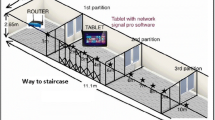Abstract
The capability of a 3-D ray tracing model to predict the indoor propagation of electromagnetic waves around a wedge is evaluated by comparing computed values and measured data. Measurements have been performed in order to validate the model, which is based on the Uniform geometrical Theory of Diffraction (UTD), and takes into account reflections from walls, floor and ceiling, and the diffraction from edges. The accuracy of predictions strongly depends on the knowledge of both the geometrical and physical properties of the environment in which the propagation occurs, and on the capability to evaluate the importance of the geometrically possible rays. The agreement between predicted and measured values points out that a UTD-based model is a satisfactory tool to account for indoor propagation.
Similar content being viewed by others
References
COST 231 TD(93)79 Rev. 1, Interim Report, Limerick (Ireland), Sept. 1993.
M.Born and E.Wolf, Principles of Optics, Pergamon Press: Oxford, p. 121, 1959.
W.Pauli, “On Asymptotic Series for Functions in the Theory of Diffraction of Light”, Physical Review, vol. 54, pp. 924–931, 1938.
R. G.Kouyoumjian and P. H.Pathak, “A Uniform Geometrical Theory of Diffraction for an Edge in a Perfectly Conducting Surface”, Proc. IEEE, vol. 62, pp. 1448–1461, 1974.
D. A.McNamara, C. W.Pistorius and J. A.Malherbe, Introduction to the Uniform Geometrical Theory of Diffraction, Artec Hause: London, 1990.
A.Sommerfeld, “Mathematische Theorie der Diffraktion”, Math. Ann. 47, pp. 314–374, 1896.
A.Sommerfeld, “Asymptotische Darstellung von Formeln aus der Beugungstheorie des Lichtes”, J. reine angw. Math., vol. 158, pp. 199–208, 1928.
A.Sommerfeld, Optics. Lectures on Theoretical Physics, vol. IV, Academic Press: New York, 1954.
F.Oberhettinger, “On Asymptotic Series for Functions Occurring in the Theory of Diffraction of Waves by Wedges”, J. Math. Phys., vol. 34, pp. 245–255, 1955.
F.Oberhettinger, “On the Diffraction and Reflection of Waves Publses by Wedges and Corners”, J. Res. Nat. Bureau of Standards, vol. 61, pp. 343–364, 1958.
A.Wiegrefe, “Uber einige mehrwertige Losungen der Wellengleichung und ihre Anwendung in der Beugungstheorie”, Ann. der Phys., vol. 39, pp. 449–484, 1912.
R. G.Kouyoumjian, “Asymptotic High-Frequency Methods”, Proc. IEEE vol. 53, pp. 864–876, 1965.
J. B. Keller, “The Geometrical Theory of Diffraction”, J. Opt. Soc. of America, vol. 52, pp. 116–130.
D. L.Hutchins and R. G.Kouyoumjian, “Asymptotic Series Describing the Diffraction of a Plane Wave by a Wedge”, ElectroScience Lab. Dep. Elec. Eng., Ohio State Univ., Columbus, Rep. 2183-3, Dec. 15, 1969.
R. G.Kouyoumjian and P. H.Pathak, “The dyadic diffraction coefficient for a perfectly-conducting wedge”, ElectroScience Lab. Dep. Elec. Eng., Ohio State Univ., Columbus, Rep. 2183-4, June 5, 1970.
R.Harrington, Time-Harmonic Electromagnetic Fields, McGraw-Hill: New York, 1961.
G. F.Herrmann, “Numerical Computation of Diffraction Coefficients”, Trans. Antennas and Propagation, vol. AP-35, pp. 53–61, 1987.
G. F.Herrmann and S. M.Strain, “Numerical Diffraction Coefficients in the Shadow Transition Region”, Trans. Antennas and Propagation, vol. 36, pp. 1244–1251, 1988.
M.Abramowitz and I. A.Stegun, Handbook of Mathematical Functions, Dover: New York, 1972.
J. D.Jackson, Classical Electrodynamics, J. Wiley and Sons: New York, 1962.
Author information
Authors and Affiliations
Rights and permissions
About this article
Cite this article
Stola, L., Urso, G.L. & Tenani, P. Indoor propagation: Experimental validation at 1.7 GHz of a UTD-based approach. Wireless Personal Communications 3, 225–241 (1996). https://doi.org/10.1007/BF00354872
Issue Date:
DOI: https://doi.org/10.1007/BF00354872




